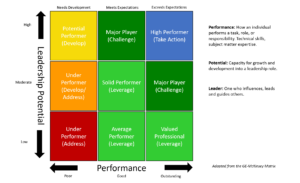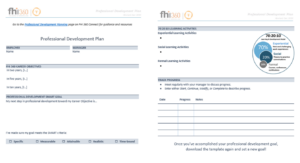So, you want to ramp up your leadership skills but aren’t sure where to start. First, it’s expensive, and you don’t have the luxury of being out of the office for days at a time. Or, it could be that the latest leadership training course focuses more on theory and less on relevant experience and practical application. Or maybe, you come away inspired after a great leadership program only to find your organization’s environment doesn’t support the new ideas and practices—so how will you enact any real change?
Luckily, there are many ways you can tailor a leadership development strategy that aligns with your budget, schedule, experience and readiness. My team uses AIM (Assess-Identify-Monitor, banner image), a comprehensive approach you can apply to personal learning while determining effective tools to support and track success.
Assess
A 2010 Cornell University study found self-awareness to be the strongest indicator of executive success. Leaders who acknowledged their weaknesses were better able to create teams who communicated honestly about problems and performed well in areas where the leader faced challenges. Here are some tips on assessing your leadership acumen.
Start by looking at your past and present performance. Talk to trusted colleagues and invite honest feedback. For example, where would you fall on the Performance Potential Grid? (Figure 1) To find out, consider your most recent performance review and have a frank conversation with your manager and colleagues. Wherever you plot yourself on the grid, understand that you can change; change starts with knowing where you are and shaping your professional development accordingly.

*Figure 1
Knowing yourself—your values and personality—is important to your professional development. The Life Values Inventory is a free, easy tool that provides several reports to help clarify your values. Once you have your results, compare to your organization’s values. Are they a good match? What development activities can you do to strengthen the fit?
Personality assessments can also help illustrate how you approach work, communicate with colleagues, handle conflict and manage projects. Some of the fee-based tools my team administers include Insights Discovery, CliftonStrengths, Workplace Big Five Profile, MBTI, and the FIRO-B. Costs vary by tool, and a good free option is NERIS Analytics’ 16 Personalities. Keep in mind that these tools aren’t prescriptive but understanding your strengths and potential challenges can help fine-tune your professional development planning and maximize your performance and potential.
The final step in this phase is to map out some broad career goals. Where do you see yourself in two, five, and ten years? Review your performance, potential, values and personality and write a career objective. CareerOneStop, a US federal website, is helpful for researching various occupations, toolkits and industry trends.
Identify
Once you’ve defined your career objective, consider results from your performance, potential, values and personality research. What do you need to do to get from where you are to where you want to be? What are your short- and long-term development needs? Are the systems in place to support your leadership development? Record this information in a professional development plan (Figure 2) provided by your learning and development department, or search for a template online.

*Figure 2
Next, explore how you can address those development needs. Research your organization’s formal learning, and development opportunities (consider face-to-face, virtual, eLearning and blended options) Check with your professional associations about conferences, training events, journal articles or other resources offered. Also, investigate free and low-cost online options:
- Enroll in free courses on PhilanthropyU.org with topics on data management, partnership strategies, storytelling, budgeting, and other courses for the development sector.
- Learn collaboratively and join a global community of social change learners via +Acumen.
- Review the vast leadership catalogs and audit a course at no cost (or pursue a discounted certificate or Micro Masters) from Coursera or edX.
- Take advantage of the Humentum membership benefits by accessing discounted eCornell courses and certifications focusing on leadership essentials, executive leadership, women in leadership, and more.
And be sure to consider many of the best developmental opportunities that are right in the context of your workday–things like shadowing an experienced leader, taking on a new project, or mentoring and being mentored. Add the most promising opportunities to your professional development plan.
Monitor
Professional development, much like a New Year’s Resolution, can get forgotten in day-to-day activities—especially in social development and humanitarian work where competing priorities and crisis response are the norms. Reviewing your plan monthly is a good habit and enlisting a peer coach will improve your chances of success. A study by the Association for Talent Development (ATD) found that people have a 65% chance of completing a goal when they share that goal with an accountability partner. And that success rate increases to 95% when they meet regularly with their partners to monitor progress. So, identify a peer coach to help you stay on task! Peer Coaching is effective and can be done in less than five minutes a session. Anyone can be a peer coach—a friend, family member or colleague. For more about peer coaches and establishing an Accountability Partner Agreement (Figure 3), see this article from Liberationist.org. This group that offers innovative resources to inspire and equip leaders to generate positive change.

*Figure 3
Lastly, take advantage of the many amazing apps that monitor progress and improve productivity. Try coach.me for goal-tracking or to find a professional coach; Day One for journaling and reflection; or 2Do to manage and track your tasks. Add your favorites in the comments section!
Learn more: Add these helpful articles to your leadership development reading list.
Why Leadership Development Fails to Deliver Leaders (HBR)
Why Leadership Training Fails—and What to Do About It (HBR)
What Predicts Executive Success (Green Peak and Cornell University)
Achieve Your Goals with an Accountability Partner (Liberationist)

